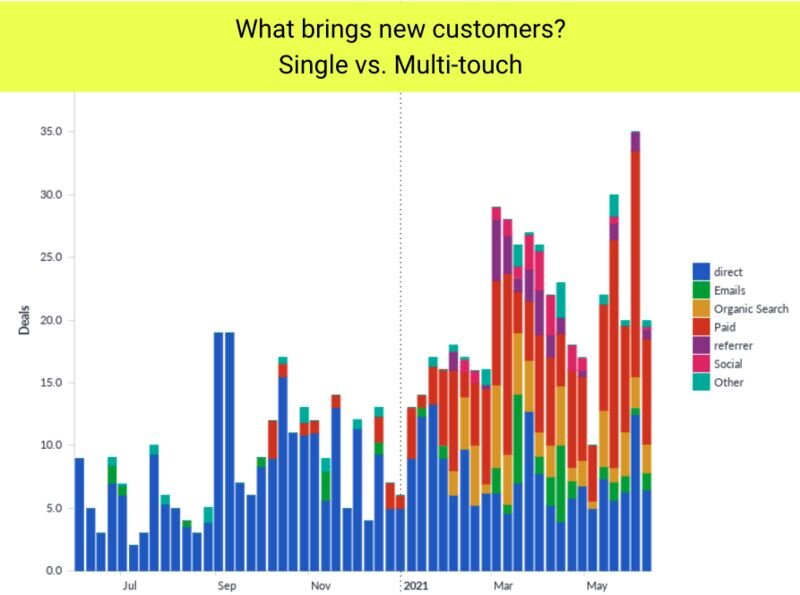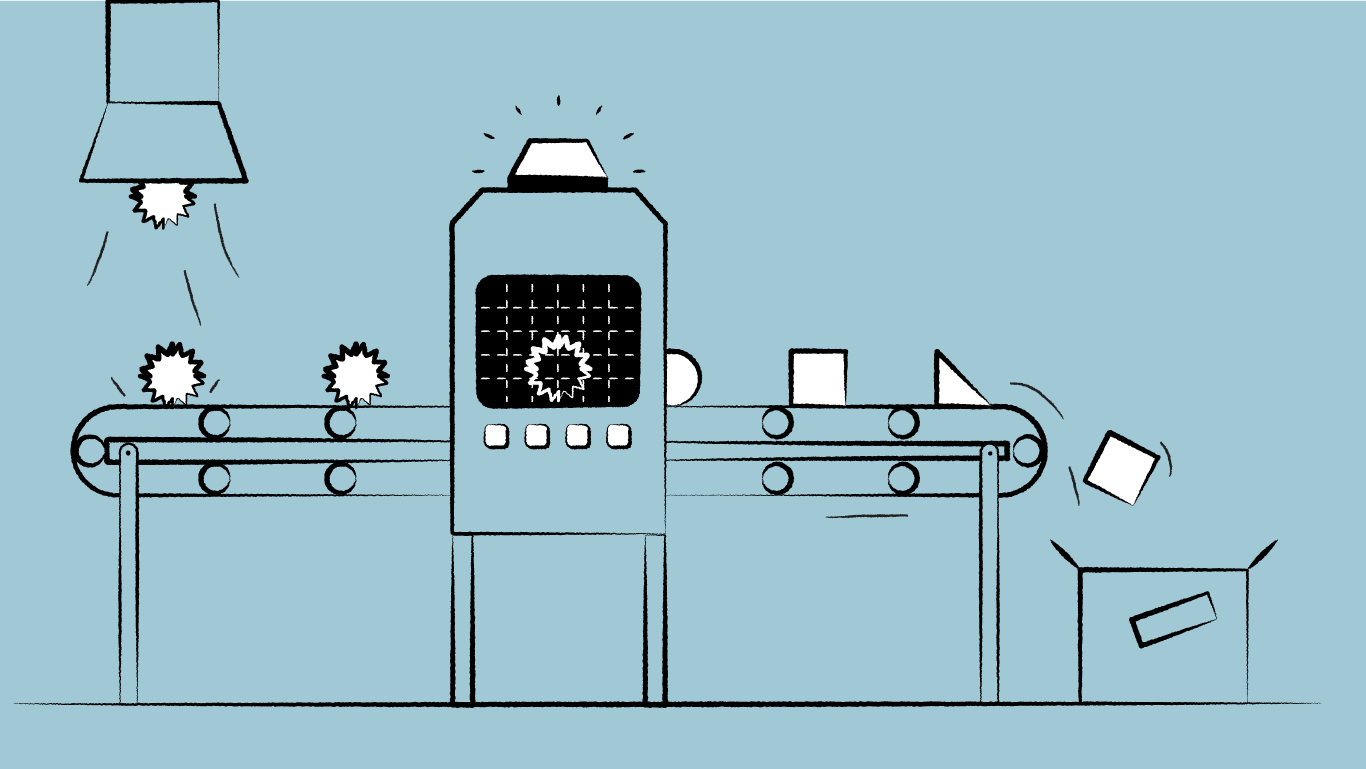Selling Dreamdata internally: a checklist
Checklist summary. You can find the full explanations below.
☑ Know how to pitch multi-touch vs. single-touch attribution
Single-touch attribution paints a tiny picture of the customer journey, leaving B2Bs with no certainty on what is working and what isn’t. Multi-touch attribution takes into account every recordable touch to offer unprecedented clarity on all efforts, and so enable data-driven decision-making on what to scale and what to scrap.
☑ Be prepared for “Can we not build that in-house?”
Attribution really isn’t a question of just pulling data out of the tools and putting them into a dataset. The complexity lies in the sum of all the intricate individual steps in the process, not least the maintenance and innovation post-setup.
☑ Involve your data/ops person(s) as early as possible
Dreamdata pulls data from your site and from across your ecosystem. In having oversight of the tech stack, ops professionals want to know how and where Dreamdata interacts with the stack. Your data scientist or CTO are also interested in how the data is being processed and handled.
☑ Know how long you actually need for a PoC
If you’re not already a Dreamdata FREE user, the PoC will take around 14 days - although this can be longer or shorter depending on the state of your data. The PoC should serve two purposes: to validate how well the product pulls data and runs it through the modelling, and, to enable you to better build the business case.
☑ Don’t underestimate the legal step
The problem here arises not so much in the legal folks reviewing the paperwork, but in where this sits in their own priority of tasks. In other words, there’s a good chance your legal team has a priority list of their own, and reviewing this contract might sit quite low on that list.
☑ Make the most of Dreamdata’s attribution experts
Having us by your side throughout the process will make sure questions, concerns, and everything else Dreamdata, are answered immediately.
Right, you’ve liked what Dreamdata has to offer and you want us set up ASAP. Only one problem, you need to convince your team and/or leadership before the attribution magic starts to happen.
From experience, we know that this isn’t always easy. Whether you’re competing with other departments for budget, have data-sceptic leaders, or have misaligned timelines, the effort to get this over the line often fails the efficiency test.
The good thing is that you’re not alone. The even better thing is that we’ve put together this checklist to make sure you know the biggest obstacles data dreamers just like you face and what can help overcome them.
Psssst. If you’ve already overcome some of them, just jump straight to the point you’re at now.
Still not fully convinced about Dreamdata? You might want to familiarise yourself with our awesome product first. Take a look at how our product works in these product videos.
How to pitch multi-touch vs single-touch attribution
One of the most persistent stumbling blocks multi-touch attribution champions face is a lack of awareness about the value of multi-touch attribution - typically from leadership.
Most B2Bs already work with single-touch attribution on their CRM tools - the ‘Original Source’, where they can see where leads are coming from. So how much value can another tool doing the “same” thing really give?
Single-touch, multi-touch attribution, potayto, potahto, right?
No.
When someone in leadership or in your team asks “but isn’t the Original Source good enough?”, here’s an argument you want to keep handy:
Single source, single-touch attribution paints a tiny picture of the customer journey - and that’s a big problem for B2Bs.
If we consider that 60% of the B2B buyer journey takes place prior to Sales being contacted, the importance of what takes place in the funnel becomes undeniable. Not least if you’re tasked with scaling conversions.
Single source, single-touch attribution only gives the credit to the (alleged) first touch, i.e. the hook that caught your customer. But what about everything else stakeholders in the account engage with during that 60%? Blog posts, comparison websites, Linkedin posts? Single-touch attribution gives no credit to these touches which if not there may have seen the customer churn.
Check out how a Dreamdata customer’s original source changed when introducing multi-touch attribution 👇
Without a clear picture of what campaigns and channels are working and which ones aren’t in taking the account through the funnel, you’re bound to end up wasting time and money on efforts that might not be paying off. Dig deeper into the advantages and disadvantages of the Original Source here.
By taking into account every recordable touch, multi-touch attribution offers unprecedented clarity into the customer journey. With this clarity, businesses can make data-driven decisions on what to scale and what to scrap, and so fuel sustainable growth.
Moving from single-touch to multi-touch attribution is the reason why Gorgias chose Dreamdata (worth sending this case to any multi-touch attribution skeptic in your organisation).
Is Google Analytics being pitched as a viable alternative? Check out this post on why Google Analytics.
Be prepared for the Build vs. Buy conversation
Chances are you’ve already been through the thought process of weighing out the pros and cons of a DIY attribution tool. And, clearly, the conclusion you’ve come to is that Dreamdata offers a better alternative in both cost and time.
This won’t stop the question of building something in-house cropping up when pitching Dreamdata to leadership/wider team.
So, when the question of whether to build or buy an attribution tool comes up - and if you’re a B2B of a certain size, it will - here are a few considerations to keep in mind:
Attribution really isn’t a question of just pulling data out of the tools and putting them into a dataset. The complexity lies in the sum of all the intricate individual steps in the process.
The devil is in the detail. If you haven’t set about collecting the right data, or things aren’t being mapped correctly, you lose the all-important overview and the ability to derive maximum value from doing revenue attribution.Maintenance and innovation after your attribution tool is set up is often ignored at the point of making a decision, despite this being crucial to gaining an enduring competitive advantage over competitors.
When you build a tool in-house you take a risk (time and cost) for something you do not yet know will bring value (or how much value).
—> All these points and more are considered in greater detail in this dedicated Build vs.Buy article.
Once this build vs. buy hurdle has been overcome, you’re on the home straight. The next three points all cater to getting over the line ASAP.
Bring data/ops people on board early in the process
It’s all too often that our champions forget to loop in the data/ops person (or CTO for smaller businesses) early in the buying process. Which always results in unexpected delays at the eleventh hour.
So why do the data/ops want/want to be involved in the first place?
As you know, Dreamdata pulls data from your site and from across your ecosystem. In having oversight of the tech stack, ops professionals want to know how and where Dreamdata interacts with the stack. Your data scientist or CTO will similarly be interested in how the data is being processed and handled.
They typically want clarity on the following:
The data cleaning process
Storing and accessing the data on BigQuery, and
Security measures
So make sure to loop the data/ops person in early so they can give their thumbs-up to the Dreamdata platform.
—> Get a head start and direct them to our data platform and Dreamdata for Ops and Data pros pages.
How long do you need to run a PoC to prove the Dreamdata product will bring value?
It’s always difficult to assess how long you need to give a software proof of concept before knowing whether it’s doing what it says on the box.
In our case, the PoC should serve two purposes: to validate how well the product pulls data and runs it through the modelling, and, to enable you to better build the business case.
So here’s the lowdown on what Dreamdata’s PoC entails and what you should expect to get out of it.
The good news is that assessing the product doesn’t require a full sales cycle.
Instead, if you’re not already a Dreamdata FREE user, the PoC will take around 14 days - although this can be longer or shorter depending on the state of your data.
The key is assessing functionality:
Are visitors being tracked?
Are form-submits in place?
Is data being pulled from your tools?
Are you seeing CRM accounts in ‘Journeys’
Is your modelling working properly? (With our ‘attribution to pipeline’ you’re able to verify that the modelling is working)
If you’ve already been using Dreamdata FREE for more than two weeks - and followed the onboarding instructions - you should also be able to validate the above.
UTM mapping, tracking gaps, historical data integration, etc. will all happen at the onboarding stage.
Legal involvement: the sooner the better
Don’t underestimate the legal side of things. We will be transferring and handling a lot of data, meaning that there needs to be legal involvement to review the data rules and the other legal paperwork related to our engagement.
Needless to say, our Data Processing Agreement adheres to the highest data privacy and handling regulation, but your legal teams will still, rightly, need to go through it in detail.
The problem here arises not so much in the legal folks reviewing the paperwork, but in where this sits in their own priority of tasks. In other words, there’s a good chance your legal team has a priority list of their own, and reviewing this contract might sit quite low on that list.
In one painful case, the legal process took as long as the ‘buying’ process.
As a result, we will endeavour to send the paperwork as early as possible in our engagement to make sure we can avoid these types of delays.
—> Get ahead and download our Data Processing Agreement here
Make the most of Dreamdata’s attribution experts
Finally, if you want your leadership to buy Dreamdata, and buy it quick, it’s best to have our attribution experts close at hand throughout the process.
This isn’t because we want to pester you across the finish line. Rather, it’s because any product buy-in comes with truckloads of questions, from how the product works to how securely data is handled.
With time being of the essence, minimizing how long it takes to respond to these questions is vital.
Having us by your side throughout the process will make sure questions, concerns, and everything else Dreamdata, are answered immediately.
So, if you haven’t already, reach out to one of our B2B attribution experts here.
Well, there we have it. Our checklist with 6 to-dos to help you sell Dreamdata internally.
☑ Know how to pitch multi-touch vs. single-touch attribution
☑ Be prepared for “Can we not build that in-house?”
☑ Involve your data/ops person(s) as early as possible
☑ Know how long you actually need for a PoC
☑ Don’t underestimate the legal step
☑ Make the most of Dreamdata’s attribution experts




